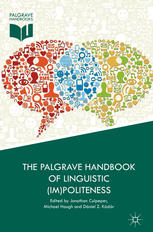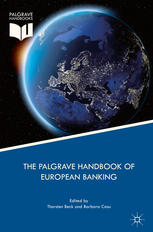The Palgrave Handbook of Linguistic Impoliteness 1st Edition by Jonathan Culpeper 1137375087 9781137375087
$50.00 Original price was: $50.00.$25.00Current price is: $25.00.
The Palgrave Handbook of Linguistic (Im)politeness 1st Edition by Jonathan Culpeper – Ebook PDF Instant Download/DeliveryISBN: 1137375087, 9781137375087
Full download The Palgrave Handbook of Linguistic (Im)politeness 1st Edition after payment.

Product details:
ISBN-10 : 1137375087
ISBN-13 : 9781137375087
Author: Jonathan Culpeper
This handbook comprehensively examines social interaction by providing a critical overview of the field of linguistic politeness and impoliteness. Authored by over forty leading scholars, it offers a diverse and multidisciplinary approach to a vast array of themes that are vital to the study of interpersonal communication. The chapters explore the use of (im)politeness in specific contexts as well as wider developments, and variations across cultures and contexts in understandings of key concepts (such as power, emotion, identity and ideology). Within each chapter, the authors select a topic and offer a critical commentary on the key linguistic concepts associated with it, supporting their assertions with case studies that enable the reader to consider the practicalities of (im)politeness studies. This volume will be of interest to students and scholars of linguistics, particularly those concerned with pragmatics, sociolinguistics and interpersonal communication. Its multidisciplinary nature means that it is also relevant to researchers across the social sciences and humanities, particularly those working in sociology, psychology and history.
The Palgrave Handbook of Linguistic (Im)politeness 1st table of contents:
1: Introduction
1 (Im)politeness
2 Why This Handbook Now?
3 What is in it?
4 Looking Forward
References
Part I: Foundations
2: Pragmatic Approaches (Im)politeness
1 Introduction
2 Classic Pragmatic Theories and Concepts
2.1 Speech Act Theory
2.2 Conversational Implicature
3 Pragmatic Concepts in Politeness Theories
3.1 Face Threatening Acts
3.2 Politeness Principles and Maxims
3.3 Politeness Strategies
3.4 Politeness Implicatures
3.5 (In)directness
3.6 Context and Contextual Variables
4 A Case Study
5 Summary and Future Directions
References
3: Sociocultural Approaches to (Im)politeness
1 Introduction
2 Key Concepts and Theories
2.1 Sociocultural Linguistics
2.2 Individualistic Views of Politeness
2.3 Traditional Approaches to Variables
3 Critical Overview of Research
3.1 Discursive Approaches to the Analysis of Politeness
3.2 Politeness as Social
3.3 Politeness as a System and a Resource
3.4 Linguistic Ideologies, Indirect Indexicality and Politeness
4 Case Studies
4.1 Conventional Politeness
4.2 Conventional Etiquette
4.3 Assertion of Control of Children by Adults (Hegemony)
4.4 Assertion That Children’s Needs Are Less Important Than Adults’ Needs
4.5 Assertion That Children Should Not Express Themselves
4.6 Below-the-lines Comments
5 Summary and Future Directions
Bibliography
4: Ideology and (Im)politeness
1 Introduction
2 Ideology
3 Ideologies of (Im)politeness
3.1 Introduction: (Im)politeness
3.2 Ideologies of (Im)politeness 1
Class
Gender
‘Race’/Ethnicity
Age
3.3 Ideologies of (Im)politeness 2
The Ideology of Rationalisation
The Ideology of Homogenisation
The Ideologies of ‘Encoded (Im)politeness’ and ‘Inferred (Im)politeness’
4 Case Study
5 Conclusion
References
5: Face and (Im)politeness
1 Introduction
2 Key Concepts and Theories
2.1 Face as the Explanation for Non-Gricean Behaviour
2.2 Face as Bestowed by Others and Emotionally Invested
2.3 Reciprocal Face-Maintenance
2.4 Face as Universal
2.5 A Person’s Face: Temporal Perspective
2.6 A Person’s Face: Contents
2.7 The Locus and Scope of Face
3 Critical Review of Research
3.1 Politeness, Face and Facework: A Tale of Amicable Separation
3.2 The Range of Face and Facework Study
3.3 The Locus and Scope of Face
3.4 The Contents of Face
4 Case Study
5 Summary and Future Directions
References
6: Power, Solidarity and (Im)politeness
1 Introduction
2 Key Concepts and Theories
2.1 Power
2.2 Solidarity/Distance
3 Critical Overview of Research
3.1 Expressive (Im)politeness
How Do People Make Assessments of P & D?
How Do P and D Interconnect?
How Do P & D Influence (Im)politeness Strategies?
3.2 Classificatory (Im)politeness
3.3 Interactional Achievement (Im)politeness
3.4 Researching P, D and (Im)politeness
4 Case Study
5 Summary and Future Directions
References
7: Indexicality and (Im)politeness
1 Introducing Indexicality and (Im)politeness
2 Indexicality
2.1 Indexicality as the Study of Deixis
2.2 Schema of Interpretation
2.3 Indexicality as a Social Process
3 (Im)politeness
4 Researching (Im)politeness and Indexicality
4.1 The Social Significance of Indexicality in Linguistic (Im)politeness
4.2 Direct Marking of (Im)politeness Versus Marking of Stances, Activities, Identities
5 Case Study
5.1 Aims
5.2 Method
5.3 Sample Analysis
5.4 Findings
6 Summary/Conclusions
References
8: Convention and Ritual (Im)politeness
1 Introduction
2 Key Concepts and Theories
2.1 Convention
2.2 Ritual
3 Critical Overview of Research
3.1 Conventionality and (Im)politeness
3.2 Ritual
Interactional Situatedness
Politeness and Ritual
4 Case Studies
4.1 From Urban Streetball to Academia and Beyond: The Emergence of an Interactional Convention
5 Summary and Future Directions
References
Part II: Developments
9: Impoliteness
1 Introduction
2 Concepts and Other Distinctive Features of Impoliteness Frameworks
2.1 Impoliteness Meta-language
2.2 Intention
2.3 Emotions
3 Overview of Research
3.1 A Brief History of Impoliteness Research
3.2 From Strategies to Formulae
3.3 Co-texts and Contexts
3.4 Co-texts
3.5 Contexts
4 Case Study: ‘Lose some Weight Baby Girl’
4.1 Context
4.2 Power
McHenry’s Power
The Worker’s Power
The Audience’s Power
4.3 Impoliteness Formulae
5 Future Directions
References
10: (Im)politeness and Identity
1 Introduction
2 Face and Identity in (Im)politeness Research
2.1 Face and Identity
2.2 Dialectics: The Understanding of Discursive Identity
2.3 Face and Identity Revisited
3 Identity and (Im)politeness
4 Case Study: Golden Dawn: Solidarity/Deference and Aggression as Indexes of Identity Constructi
4.1 Data and Background
4.2 Procedure and Framework
4.3 Analysis
5 Conclusion
Appendix
Transcription Conventions
References
11: (Im)politeness and Relationality
1 Introduction
2 Key Concept and Theories
3 Critical Overview of Research
4 Case Studies
4.1 Case Study 1: Balancing Obligations
4.2 Case Study 2: Relational Ties and Relational Entitlements
4.3 Summary
5 Conclusion and Future Directions
References
12: (Im)politeness and Emotion
1 Introduction
2 The Fundamental Links Between Emotion and Interpersonal Pragmatics
3 Emotions and (Im)politeness in (Im)politeness Research
4 The Links of Emotions to Cognition, Sociality and Communicative Observables
4.1 Emotions and Cognition
4.2 Emotions and Sociality
4.3 Communicative Observables of Emotions
5 Sketching Paths for Empirical Analysis
6 Conclusions and Outlook
References
13: (Im)politeness and Mixed Messages
1 Introduction
2 Some Background on Irony, Ritualised Banter and Teasing
2.1 Irony and Conversational Implicature
2.2 Irony and the Echoic Account
2.3 Ritualised Banter
2.4 Teasing
3 Mixed Messages and (Im)politeness
3.1 Mixed Messages in Classic Politeness Theories
3.2 The Metapragmatics of Mixed Messages
3.3 The Mix of Mixed Messages
Convention-driven
Context-Driven
3.4 The Conventionalisation of Mixed Messages
3.5 The Functions of Mixed Messages
3.6 The Perception of Mixed Messages
4 Case Study: Frontstage and Backstage Evaluations of Teasing
5 Summary and Future Directions
References
14: (Im)politeness: Prosody and Gesture
1 Introduction
2 Key Concepts and Theories
2.1 Prosody
2.2 The Frequency Code
2.3 Gesture
3 Critical Overview of Research
3.1 What Role Does Prosody Play in the Communication of (Im)politeness?
3.2 Can the Frequency Code Work Across Different Cultures, and Different Modes of (Im)politenes
3.3 What Role Does Gesture Play in the Communication of (Im)politeness, and How Do Gesture and
4 Case Studies
4.1 Production Data: Korean
4.2 Perception Data: Catalan
5 Summary and Future Directions
References
15: Experimental Approaches to Linguistic (Im)politeness
1 Introduction
2 Key Concepts and Methods
3 Critical Review of Relevant Empirical Research
3.1 Initial Tests of Brown and Levinson’s Politeness Theory
Ordering of Superstrategies
Imposition, Power and Distance
3.2 Experimental Extensions of Brown and Levinson’s Politeness Theory
Person Perception
Powerful vs. Powerless Language
Processing Politeness: Memory and Comprehension
Tests of Politeness and Reasoning
4 Case Studies
4.1 Experiments on Discourse Markers
4.2 Politeness and Parkinson’s Disease
5 Summary and Future Directions
References
16: (Im)politeness and Developments in Methodology
1 Introduction
2 Key Concepts: Methods and Methodologies
3 Critical Overview of Data Collection Methods
3.1 Armchair Approaches
3.2 Laboratory Approaches
3.3 Field Approaches
Diary Studies
Interactional Approaches
Philological Approaches
Corpus-based Studies
The Semantics and Meta-discourse of (Im)politenes
4 Case Study: 30 Years of Politeness Research
5 Summary and Future Directions
References
Part III: (Im)politeness and Variation
17: Historical (Im)politeness
1 Introduction
2 Key Concepts: Comparability, Historicity and Data
3 Critical Overview of Research
3.1 Discourse Strategies
3.2 Terms of Address
3.3 Speech Acts
3.4 Interjections and Expletives
3.5 Negotiation of Politeness and (Im)politeness
4 Case Studies
4.1 Semantics and Types of (Im)politeness in the History of English
4.2 Impoliteness in Verbal Duels: A Discursive Approach to ‘The Flyting of Dunbar and Kenned
5 Summary and Future Directions
References
18: (Im)politeness: Language Socialization
1 Introduction
2 Key Concepts and Theories
3 Critical Overview of Research
3.1 Interactional Routines
3.2 Requests and Directives
3.3 Honorifics
4 Case Studies: Indirectness, Attentiveness, and Honorifics in Japanese Language Socialization as
4.1 Children in and around the Home
Indirect Requests and Directives
Honorifics
4.2 Adults in the Business World
Attentiveness to Others’ Needs: kikubari
Honorifics
5 Summary and Future Directions
Appendix
References
19: (Im)politeness: Learning and Teaching
1 Introduction
2 Key Concepts in and Approaches to L2 (Im)politeness
3 Overview of Previous Research in L2 (Im)politeness
3.1 Can (Im)polite Behaviour Be Learned and Taught?
3.2 Pragmatic Approach: Teaching Conformity
3.3 Discursive Approaches: Interactional Achievement
3.4 Identity Management
4 Pedagogical Model for Teaching (Im)polite Behaviour in the FL Classroom
4.1 Raising Awareness
4.2 Pragmatic Input: Identification and Reflection of (Im)polite Behaviour
4.3 Teaching Grammar as a Communicative Resource
4.4 Practicing Polite and Impolite Language in the Classroom
5 Summary and Future Directions
References
20: (Im)politeness and Gender
1 Introduction
2 Key Concepts and Theories
3 Critical Overview of Research
4 Case Studies
5 Summary and Future Directions
References
21: (Im)politeness and Regional Variation
1 Introduction
2 Key Concepts and Theories: Region and Regional Variation
3 Critical Overview of Research on (Im)politeness and Regional Variation
3.1 Studies on Varieties of English
3.2 Studies on Varieties of Spanish
3.3 Studies on Varieties of Other Languages
4 Case Studies
4.1 Case Study 1: Regional Variation in Appropriate Behaviour in American, Canadian, Irish and E
4.2 Case Study 2: Regional Variation in Rapport Management in Service Encounters in Ecuadorian (
5 Summary and Future Directions
References
22: (Im)politeness and Cultural Variation
1 Introduction
2 Early Approaches to Politeness and Culture
2.1 Universalistic Perspectives on Politeness
2.2 Positive and Negative Politeness Cultures
3 The Discursive Turn
3.1 Situatedness and Generalisations of Politeness
3.2 Intracultural Variation
3.3 Cross-Cultural Variation
4 Case Study: Compliments
5 Concluding Remarks
References
23: Intercultural (Im)politeness
1 Introduction
2 Key Concepts
2.1 Culture and Communication
2.2 Warranting Analyses of Encounters as Intercultural
2.3 Perspectives, Footings and the Emic/Etic Distinction
2.4 Identities and Identification
2.5 Accommodation and Interculturality
3 Approaches in Intercultural (Im)politeness Research
4 Case Studies
4.1 Taking Offence in Intergroup Encounters
4.2 Metalexemes in Intercultural Contact
5 Summary
References
Part IV: (Im)politeness in Specific Contexts
24: (Im)politeness in the Workplace
1 Introduction�
2 Definitions, Key Concepts and Theoretical Approaches
2.1 Defining (Im)politeness
2.2 Theoretical Framework
3 (Im)politeness in the Workplace: A Brief Overview
4 Methods of Collecting Data
5 Analysing (Im)politeness in Talk at Work
5.1 From Country to Country
5.2 From Institution to Institution
5.3 From Company to Company
6 Future Directions for Research
7 Transcription Conventions
References
25: (Im)politeness in Service Encounters
1 Service Encounters in Late Modernity
2 Towards a Definition of Service Encounters
3 Research on (Im)politeness in Service Encounters
3.1 Face-To-Face Service Encounters
3.2 Telephone-Mediated Service Encounters
3.3 Online Service Encounters: A Changing World
4 Disattending Customers’ Positive Comments: A Case Study
5 Conclusion
References
26: (Im)politeness in Health Settings
1 Introduction
2 Key Concepts and Theories: (Im)politeness in Healthcare Contexts
2.1 Scope of Research
2.2 e-health
2.3 Culture
2.4 Theory and Method
3 Critical Overview of Research: Illustrating Emergent Themes of Relational Work in Health Conte
4 Conclusions and Future Directions for Research
References
27: (Im)politeness in Legal Settings
1 Introduction
2 Key Concepts and Theories
2.1 The Relevance of (Im)politeness in Legal Settings
2.2 Delineating Politeness and Impoliteness in Legal Settings: Via a Continuum
2.3 Dealing with the ‘Problem’ of Intentionality
3 Outline of the Fourteen Studies
3.1 Face-Threatening Acts and the Courtroom
Courtroom-Based (Im)politeness Studies Based on Modern Datasets
Courtroom-Based (Im)politeness Studies Making Use of Historical Datasets
3.2 FTAs and Appellate Court Opinions
3.3 FTAs and Judicial Hearings
3.4 FTAs and Police Interactions
4 Case Study
5 Future Directions
References
28: Facework and (Im)politeness in Political Exchanges
1 Introduction
2 Facework in Political Settings: Key Concepts
3 Critical Overview of Political Genres Studied
4 A Case Study: Legislative Hearings
5 Summary and Future Directions
References
29: (Im)politeness in Fictional Texts
1 Introduction
2 Key Concepts and Theories
2.1 Fiction as Linguistic Data
2.2 Advantages of Fiction as Data
3 Critical Overview of Research
3.1 Countering Criticisms of Brown and Levinson’s Model Through Reference to Fiction
3.2 Testing and Developing Brown and Levinson’s Model Through the Analysis of Fiction
3.3 (Im)politeness and Foregrounding
3.4 (Im)politeness for Characterisation and Plot Development
4 Case Study
5 Summary and Future Directions
References
30: (Im)politeness in Digital Communication
1 Introduction
2 Key Concepts and Theories
2.1 Asynchronous Versus Synchronous
2.2 Private-Oriented Networks Versus Public-Oriented Networks
2.3 Relational Versus Task-Oriented
2.4 Interaction-Focused Versus Declaration-Focused
2.5 Anonymity
2.6 Longevity
2.7 CMC versus Face-to-face Communication
3 Critical Overview of Previous Research
3.1 Digital Relationships, Communities, and Identity
3.2 Netiquette
3.3 (Im)politeness in Digital Media
Email
Discussion Boards/UseNet/BBSs
Chat, Virtual Worlds and Online Gaming
SMS/Text Messages
Blogs and Microblogs
Social Network Sites (e.g. Facebook, Instagram)
3.4 Methods in Digital (Im)politeness Research
Methodological Difficulties in Data Collection and Analysis
Ethical Considerations
4 Case Study: Identifying and Managing Impoliteness in Online Gaming
5 Summary and Future Directions
People also search for The Palgrave Handbook of Linguistic (Im)politeness 1st:
the palgrave handbook of applied linguistics research methodology
the palgrave handbook of romani language and linguistics
the palgrave handbook of celtic languages and linguistics
the palgrave handbook
the palgrave handbook of russian thought
Tags: The Palgrave, Handbook, Linguistic, Impoliteness, Jonathan Culpeper
You may also like…
Politics & Philosophy - Anthropology
The Palgrave Handbook of the Afterlife 1st Edition Yujin Nagasawa
Politics & Philosophy
The Palgrave Handbook of European Banking 1st Edition Thorsten Beck
Politics & Philosophy - Politics
The Palgrave Handbook of Anarchism 1st Edition by Carl Levy, Matthew Adams 3319756192 9783319756196
Politics & Philosophy
The Palgrave Handbook of International Development 1st Edition Jean Grugel
Politics & Philosophy - Social Sciences
The Palgrave Handbook of Sexuality Education 1st Edition by Louisa Allen 1137400338 9781137400338
Politics & Philosophy - Social Sciences
Linguistics - Linguistics
English Language Description Variation and Context 2nd Edition Jonathan Culpeper











